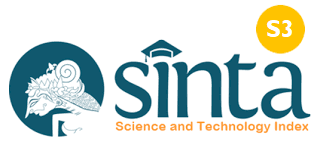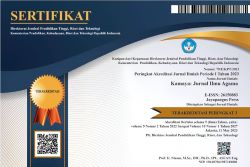Tradisi Reboan Sebagai Upacara Pitra Puja Pada Masyarakat Hindu Jawa Di Lampung (Kajian Komunikasi Sosio-Religius)
Keywords:
Reboan Tradition, Pitra Puja, Javanese Hindu Society, Change SocialAbstract
The tradition of Hindus in Pujodadi Village, Pesawaran District, Lampung, the Reboan tradition is an important part of respecting their ancestors. For Hindus, the tradition of Reboan is not only carried out on certain counts which are usually carried out to honor ancestors by the general public, after a thousand days ancestral worship is still carried out. There are two identifications that formulate the problem in this study, namely the meaning of the Reboan tradition as the Pitra Puja Ceremony on the Javanese Hindu Society in Lampung and the implications of the Reboan tradition as the Pitra Puja Ceremony on the Javanese Hindu Society in Lampung. The thesis research method uses a type of qualitative descriptive research method with a phenomenological approach and data collection from the results of interviews, documentation, and observation, then the authors analyze the data with analysis in the field then do data reduction, data presentation, and finally the conclusion. The results of the study show that the meaning of the Reboan Tradition is an activity carried out to strengthen the kinship among Hindus in Pujodadi Lampung Village to improve Sraddha and Bhakti through the pitra puja ceremony. The implications of the Reboan Tradition for Javanese Hindus in Pujodadi in the socio-religious aspects show a better understanding of Sraddha and Bhakti. In the social aspect, the interaction between Javanese Hindus in Pujodadi is getting better which is shown by the increasing sense of kinship among the people.
References
Cresswell, J. W. (2015). Penelitian Kualitatif dan Desain Riset Memilih Diantara Lima Pendekatan. (S. Z. Qudsy, Ed.) (III). Yogyakarta: Pustaka Pelajar.
Donder, I. K. dan I. K. W. (2012). Teologi Sosial Persoalan Agama dan Kemanusiaan. (S. C. Dash, Ed.) (I). Surabaya: Paramita.
Hemamalini, K. (2018). Menelusuri Dinamika Hindu Etnis Tionghoa. (U. Suhardi, Ed.) (Edisi 1). Surabaya: Paramita.
Karaman, Y. (2017). Cerita Rakyat dan Budaya Nasional. Surakarta: CV Kekata Group.
Koentjaraningrat. (2007). Manusia dan Kebudayaan di Indonesia. Jakarta.
Maharta, N. (2014). Pengembangan dan Pendalaman Agama Hindu. Lampung: CV. Seruni Bandar Lampung.
Pandit, B. (2006). Pemikiran Hindu (Pokok-Pokok Pikiran Agama Hindu Dan Filsafat). (I. D. Paramita, Ed.) (I). Surabaya: Paramita.
Prabhupada, S. S. A. B. S. (2006). Bhagavadgita Menurut Aslinya. Jakarta: The Bhakti Vedanta Book Trust.
Sivananda, S. S. (2003). Intisari Ajaran Hindu (I). Surabaya: Paramita.
Sugiyono. (2006). Metode Penelitian Kuantitatif, Kualitatif dan R & D. Bandung: Alfabeta.
Suhardi, U. (2013). Kajian Bentuk Dan Makna Nilai Filosofis Lingga Dalam Perspektif Ajaran Hindu (Studi Pemujaan Lingga Di Desa Linggoasri, Kecamatan Kajen, Kabupaten Pekalongan - Jawa Tengah). Denpasar.
Swastika, I. ketut pasek. (2009). Pitra Puja Ngaben Lan Nyekah Mamukur. Surabaya: Paramita.
Titib, I. M. (2003). Teologi & Simbol-Simbol dalam Agama Hindu. Surabaya: Paramita.
Wiana, I. K. (1999). Arti dan Fungsi Sarana Persembahyangan. Jakarta: Yayasan Wisma Karma Jakarta.
Wiana, K. (2007). Tri Hita Karana Menurut Konsep Hindu. Surabaya: Paramita.
Wikarman. I Nyoman Singgin. (2002). Ngaben (Upacara dari Tingkat Sederhana sampai Utama). Surabaya: Paramita.
Downloads
Published
How to Cite
Issue
Section
License
An author who publishes in the Kamaya : Jurnal Ilmu Agama agrees to the following terms:
- Author retains the copyright and grants the journal the right of first publication of the work simultaneously licensed under the Creative Commons Attribution-ShareAlike 4.0 License that allows others to share the work with an acknowledgement of the work's authorship and initial publication in this journal
- Author is able to enter into separate, additional contractual arrangements for the non-exclusive distribution of the journal's published version of the work (e.g., post it to an institutional repository or publish it in a book) with the acknowledgement of its initial publication in this journal.
- Author is permitted and encouraged to post his/her work online (e.g., in institutional repositories or on their website) prior to and during the submission process, as it can lead to productive exchanges, as well as earlier and greater citation of the published work (See The Effect of Open Access).
Read more about the Creative Commons Attribution-ShareAlike 4.0 Licence here: https://creativecommons.org/licenses/by-sa/4.0/.





